

By Ian Walker. United Kingdom.
[All pictures taken on the Nikon Coolpix 4500 Digital Camera, the article is best viewed in 1280 pixel width].
With the loss of habitat to wildlife in much of the U.K. the humble garden pond becomes an important sanctuary for amphibians,
aquatic insects and the larval stages of damsel flies and dragon flies besides a myriad of smaller insects and crustaceans. My own
garden pond is only about five feet long by four feet wide but provides hours of interest especially during the summer months and is
when several of these pictures where taken.
...............

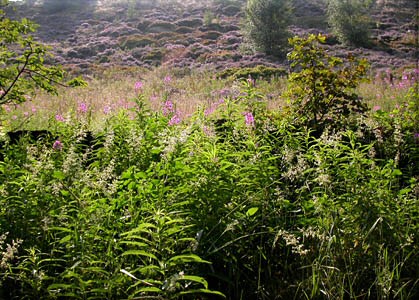
Pond and Heath.
The above images show part of the 'wildlife' pond in my small back garden and typical habitat of the butterflies shown in this
article.
Provided you haven't got very small children, adding a garden pond no matter how small will increase enormously the amount of wildlife
coming into your garden and will also give you a lot of natural history photographic possibilities right on your doorstep !
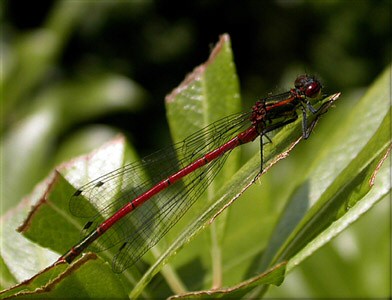
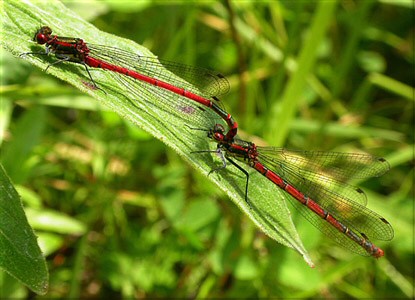
Damsel Flies.
These beautiful creatures spend most of their life as a larval stage within the pond, eating just about anything within reach such as
small aquatic insects and crustaceans, the adults can be seen from late spring to early summer depending on the species.
Photographically they are quite demanding since they have excellent eyesight and don't remain in one place very long. Keeping the depth of field to
a minimum reduces distracting vegetation, try using an adjustable circular polarising filter to minimize harsh reflections coming off the leaves in direct
sunlight. If you have a Nikon digicam with 28mm threaded lens, Nikon make a nice wallet containing UV, Polarizer and ND4 ND8 filters available from
most good digital camera shops.
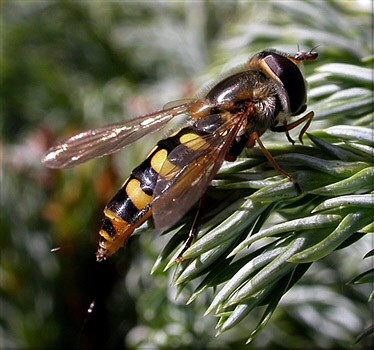
Hover Fly.
The larval stage of hover flies have a voracious appetite for greenfly [aphids] and have become a great ally for the enthusiastic
gardener.
These are a good subject for starting out on 'super' macro due to their tolerance for getting very close without flying off, here the Nikon has done a
good job of detailing individual hairs on the head and thorax .
|
|
|
Four Images of the Small Copper Butterfly.
[Lycaena phlaeas].
These small, exquisite butterflies can be seen most of the summer period and frequent dry banks. The males establish a small territory
from which to chase females and drive off other males. Always very active it can't sit still even when feeding but circles round the
flower heads, males are smaller than females and the small green caterpillars feed on sorrels, [Rumex acetosa and Rumex acetosella].
Hint: try to find backgrounds that will not be too distracting if you are using a small depth of field to highlight the butterfly, the bottom right image is a good
example. Some of the best images will be in shadow areas free from direct sunlight, especially if photographing yellows which 'burn-out' very easily, the
colours will also be a lot richer.
|
|
|
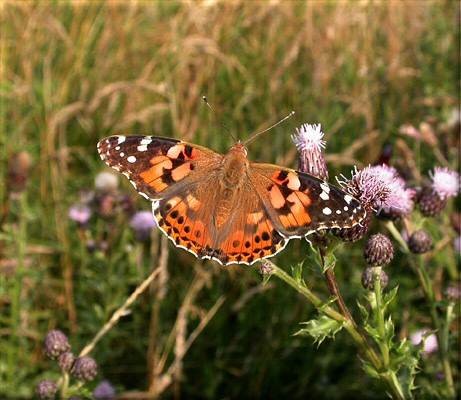
The Painted Lady Butterfly.
[Cynthia cardui].
These magnificent butterflies normally fly to the British Isles from North Africa, the numbers vary greatly each year, commonly seen
feeding on thistles, this is also the food plant of the caterpillar. The caterpillars are commonly attacked by parasitic wasps which lay
their eggs within the caterpillar and eventually kill their host.
These butterflies are quite a challenge to photograph, sometimes you can't get within eight feet and other times they seem quite obliging.

Bumble Bee.
Just emerging from a bindweed flower - complete with pollen attached to its hairs!
Although common I have found the bumble bee one of the most difficult subjects to photograph.
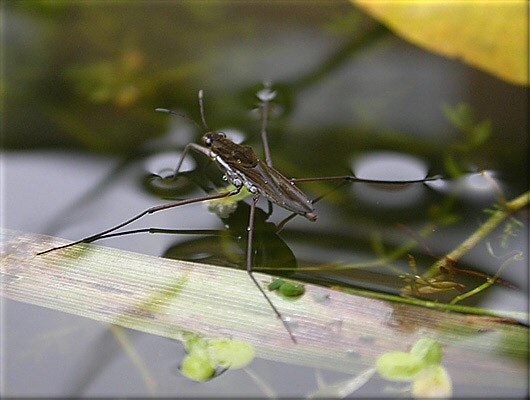
Pond Skater.
Using surface tension these insects skim the water looking for other insects trapped on the water, once found one or more
immediately pounce on their prey and suck the contents of the insect dry using their modified mouth parts similar to a beak.
Always active, they can see you coming and shoot across the pond in all directions, try using a polarising filter to minimize reflections!
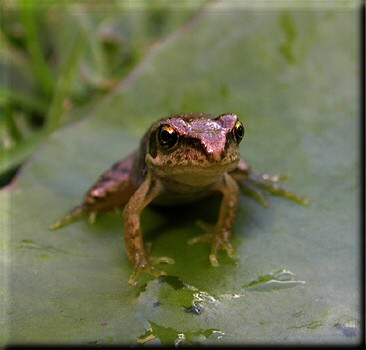
A Tiny Froglet.
Barely a third of an inch long resting on a water plant, with much of its habitat gone garden ponds provide refuge, in return
the frogs will consume your slugs!
OK, I cheated on this one, I saw this little frog jumping across the lawn, so quickly sat him on a wettened pond leaf, having fulfilled his
photographic debut he was placed in the pond where he duly paddled away none the worse for the encounter.
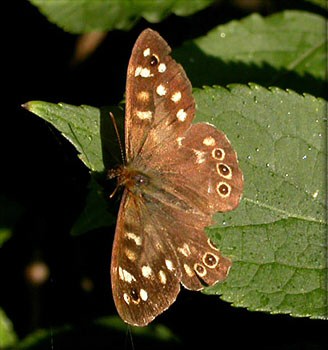
Speckled Wood Butterfly.
[Pararge aegeria].
These butterflies are not common in the industrial areas of northern England where I live, I was lucky to have my camera when
I came across this one in a clearing adjacent to a small wooded glade, the green caterpillars feed on a wide variety of grasses.
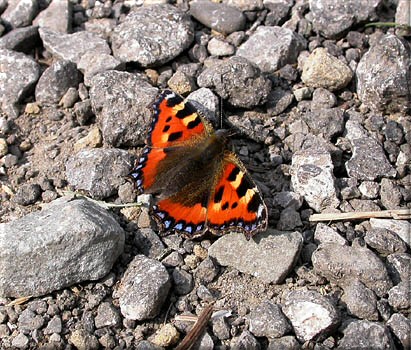
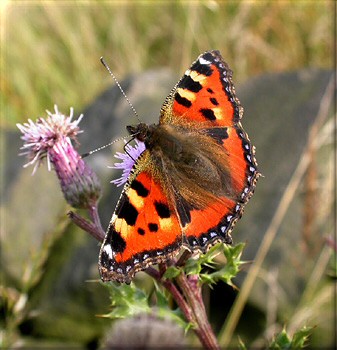
Small Tortoiseshell Butterfly.
[Aglais urticae].
Two typical shots of a very handsome butterfly, on the left sunning itself on a gravel path and on the right feeding on thistles, the
eggs are layed on stinging nettles the females being very particular on finding just the right young tender plants in sunny locations.
The caterpillars can be subject to tachinid flies [Phryxe vulgaris], the grub lives within the caterpillar killing it before it pupates.
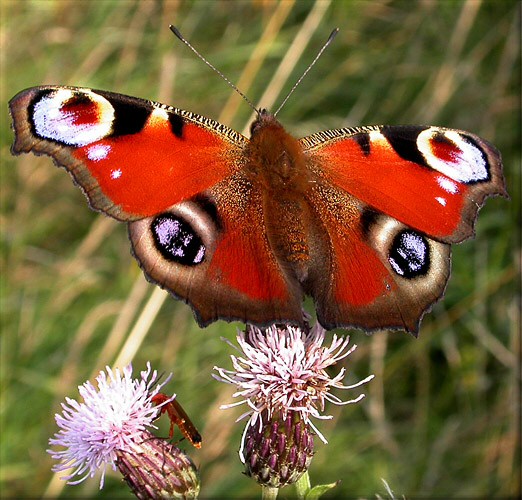
Peacock Butterfly.
[Inachis io].
With wings closed the peacock is excellently camouflaged by dull variegated markings, however when threatened the peacock
can intimidate its attacker by suddenly opening its wings whilst rubbing the forewings and hindwings together which produces
a rustling noise - enough to possibly scare a rodent away! The caterpillar which is covered in protective spines feeds on nettles.
the end.
Comments to the author, Ian
Walker, are welcomed.
Please report any Web problems or offer general comments to the Micscape Editor.
Micscape is the on-line monthly magazine of the Microscopy
UK web
site at Microscopy-UK